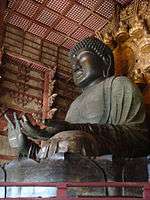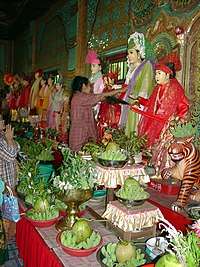Four Heavenly Kings
The Four Heavenly Kings are four Buddhist gods, which originate from the Indian version of Lokapalas, each of whom is believed to watch over one cardinal direction of the world. In Chinese mythology, they are known collectively as the "Fēng Tiáo Yǔ Shùn" (simplified Chinese: 风调雨顺; traditional Chinese: 風調雨順; lit.: 'Good climate') or "Sì Dà Tiānwáng" (Chinese: 四大天王; lit.: 'Four Great Heavenly Kings'). In the ancient language Sanskrit they are called the "Chaturmahārāja" (चतुर्महाराज), or "Chaturmahārājikādeva": "Four Great Heavenly Kings". The Hall of the Heavenly Kings is a standard component of Chinese Buddhist temples.

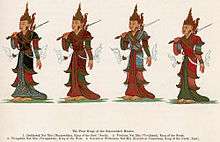
Names
The Kings are collectively named as follows:
| Language | Written form | Romanization | Translation |
|---|---|---|---|
| Sanskrit | चतुर्महाराज | Chaturmahārāja Chaturmahārājikā |
Four Great Kings |
| लोकपाल | Lokapāla | Guardians of the World | |
| Sinhala | සතරවරම් දෙවිවරු | Satharawaram Dewi | Four Privileged/Bestowed Gods |
| Burmese | စတုလောကပါလ စတုမဟာရာဇ်နတ် |
IPA: [sətṵ lɔ́ka̰ pàla̰] IPA: [sətṵ məhà ɹɪʔ naʔ] |
Loanword from catulokapāla loanword from catumahā + king nats |
| Chinese | 天王 | Tiānwáng | Heavenly Kings |
| 四天王 | Sì Tiānwáng | Four Heavenly Kings | |
| 四大天王 | Sì Dà Tiānwáng | Four Great Heavenly Kings | |
| Korean | 天王/천왕 | Cheonwang | Heavenly kings |
| 四天王/사천왕 | Sacheonwang | Four heavenly kings | |
| 四大天王/사대천왕 | Sadae Cheonwang | Four great heavenly kings | |
| Japanese | 四天王 | Shitennō | Four heavenly kings |
| Vietnamese | 四天王 | Tứ Thiên Vương | Four heavenly kings |
| Tibetan | རྒྱལ༌ཆེན༌བཞི༌ | rgyal chen bzhi | Four great kings |
| Mongolian | ᠳᠥᠷᠪᠡ ᠮᠠᠬᠠᠷᠠᠨᠵᠠ Тэнгэрийн дөрвөн хаан |
Tengeriin dörwön xaan | Four kings of the sky |
| Thai | จาตุมหาราชา | Chatumaharacha | Four Great Kings, loan word from catumahārāja (Pali) |
| จตุโลกบาล | Chatulokkaban | Four Guardians of the World, loan word from catulokapāla (Pali) |
The Four Heavenly Kings are said to currently live in the Cāturmahārājika heaven (Pali: Cātummahārājika, "Of the Four Great Kings") on the lower slopes of Mount Sumeru, which is the lowest of the six worlds of the devas of the Kāmadhātu. They are the protectors of the world and fighters of evil, each able to command a legion of supernatural creatures to protect the Dharma.
| devanagari Sanskrit romanization |
वैश्रवण (कुबेर) Vaiśravaṇa (Kubera) |
विरूढक Virūḍhaka |
धृतराष्ट्र Dhṛtarāṣṭra |
विरूपाक्ष Virūpākṣa |
| Meaning | he who hears everything | he who causes to grow | he who upholds the realm | he who sees all |
| Description | This is the chief of the four kings and protector of the north. He is the ruler of rain. His symbolic weapons are the umbrella or pagoda. Wearing heavy armor and carrying the umbrella in his right hand, he is often associated with the ancient Indian God of wealth, Kubera. Associated with the color yellow or green.
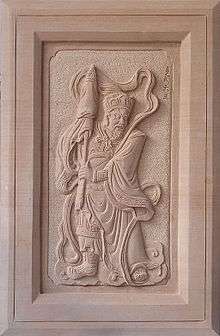 Chief of the four kings and protector of the north |
King of the south and one who causes good growth of roots. He is the ruler of the wind. His symbolic weapon is the sword which he carries in his right hand to protect the Dharma and the southern continent. Associated with the color blue.
 King of the south and one who causes good growth of roots |
King of the east and God of music. His symbolic weapon is the pipa (stringed instrument). He is harmonious and compassionate and protects all beings. Uses his music to convert others to Buddhism. Associated with the color white.
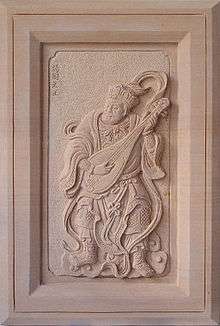 King of the east and God of music |
King of the west and one who sees all. His symbolic weapon is a snake or red cord that is representative of a dragon. As the eye in the sky, he sees people who do not believe in Buddhism and converts them. His ancient name means "he who has broad objectives". Associated with the color red.
 King of the west and one who sees all |
| Color | yellow or green | blue | white | red |
| Symbol | umbrella | sword | pipa | serpent |
| mongoose | stupa | |||
| stupa | pearl | |||
| Followers | yakṣas | kumbhāṇḍas | gandharvas | nāgas |
| Direction | north | south | east | west |
| Traditional/Simplified Chinese Pinyin |
多聞天王 / 多闻天王 Duō Wén Tiānwáng |
增長天王 / 增长天王 Zēng Zhǎng Tiānwáng |
持國天王 / 持国天王 Chí Guó Tiānwáng |
廣目天王 / 广目天王 Guăng Mù Tiānwáng |
| 毗沙門天 / 毗沙门天 | 留博叉天 / 留博叉天 | 多羅吒天 / 多罗吒天 | 毗琉璃天 / 毗琉璃天 | |
| Kanji Hepburn romanization |
多聞天 (毘沙門天) Tamon-ten (Bishamon-ten) |
増長天 Zōchō-ten |
持国天 Jikoku-ten |
広目天 Kōmoku-ten |
| 治国天 Jikoku-ten | ||||
| Hangul Hanja romanized Korean |
다문천왕 多聞天王 Damun-cheonwang |
증장천왕 增長天王 Jeungjang-cheonwang |
지국천왕 持國天王 Jiguk-cheonwang |
광목천왕 廣目天王 Gwangmok-cheonwang |
| Sino-Vietnamese | Đa Văn Thiên | Tăng Trưởng Thiên | Trì Quốc Thiên | Quảng Mục Thiên |
| Tibetan alphabet and romanization | རྣམ་ཐོས་སྲས་ (Namthöse) | ཕགས་སྐྱེས་པོ་ (Phakyepo) | ཡུལ་འཁོར་སྲུང་ (Yülkhorsung) | སྤྱན་མི་བཟང་ (Chenmizang) |
| Mongolian Script and Mongolian Cyrillic and Mongolian Latin alphabet | ᠥᠯᠥᠨ ᠦᠨᠳᠡᠰᠲᠨᠢᠢ ᠦᠽᠡᠯ (Олон үндэстний үзэл) Olon ündestnii üzel |
ᠲᠢᠶᠡᠨᠢ ᠥᠰᠥᠯᠲ (Тиений өсөлт) Tiyenii ösölt |
ᠦᠨᠳᠡᠰᠲᠨᠢᠢ ᠽᠠᠰᠤᠠᠷ ᠦᠯᠢᠴᠬᠢᠯᠭᠡᠡ (үндэсний засвар үйлчилгээ) ündesnii zasvar üilchilgee |
ᠰᠶᠡᠯᠶᠡᠰᠲᠢᠶᠡᠯ ᠰᠦᠷᠲᠠᠯᠴᠬᠢᠯᠭᠠᠠ (селестиел сурталчилгаа) syelyestiyel surtalchilgaa |
- Four Heavenly Kings statues at the royal crematorium of King Bhumibol Adulyadej of Thailand
.jpg) Vaiśravaṇa of the north direction, king of yakṣas.
Vaiśravaṇa of the north direction, king of yakṣas..jpg) Virūḍhaka of the south direction, king of kumbhāṇḍas.
Virūḍhaka of the south direction, king of kumbhāṇḍas..jpg) Dhṛtarāṣṭra of the east direction, king of gandharvas.
Dhṛtarāṣṭra of the east direction, king of gandharvas..jpg) Virūpākṣa of the west direction, king of nāgas.
Virūpākṣa of the west direction, king of nāgas.
Mythology
All four Kings serve Śakra, the lord of the devas of Trāyastriṃśa. On the 8th, 14th and 15th days of each lunar month, the Kings either send out emissaries or go themselves to inspect the state of virtue and morality in the world of men. Then they report their findings to the assembly of the Trāyastriṃśa devas.
On the orders of Śakra, the Kings and their retinues stand guard to protect Trāyastriṃśa from another attack by the Asuras, which once threatened to destroy the realm of the devas. They also vowed to protect the Buddha, the Dharma, and the Buddha's followers from danger.

According to Vasubandhu, devas born in the Cāturmahārājika heaven are 1/4 of a krośa in height (about 750 feet tall). They have a five-hundred-year lifespan, of which each day is equivalent to 50 years in our world; thus their total lifespan amounts to about nine million years (other sources say 90,000 years).
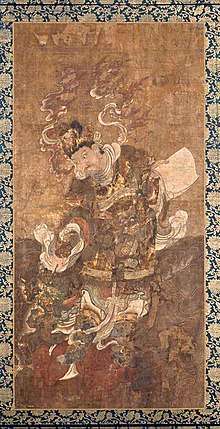
The attributes borne by each King also link them to their followers; for instance, the nāgas, magical creatures who can change form between human and serpent, are led by Virūpākṣa, represented by a snake; the gandharvas are celestial musicians, led by Dhṛtarāṣṭra, represented with a lute. The umbrella was a symbol of regal sovereignty in ancient India, and the sword is a symbol of martial prowess. Vaiśravaṇa's mongoose, which ejects jewels from its mouth, is said to represent generosity in opposition to greed.
| Tamon-ten
(north) |
||
| Kōmoku-ten
(west) |
Heavenly Kings (Japanese) |
Jikoku-ten
(east) |
| Zōjō-ten
(south) |
- Statues of the Four Heavenly Kings of Jikō-ji, Takasago, Hyōgo, Japan.
- Jikoku-ten (east)
- Zōjō-ten (south)
- Kōmoku-ten (west)
- Tamon-ten (north)
See also
References
- Chaudhuri, Saroj Kumar. Hindu Gods and Goddesses in Japan. New Delhi: Vedams eBooks (P) Ltd., 2003. ISBN 81-7936-009-1.
- Nakamura, Hajime. Japan and Indian Asia: Their Cultural Relations in the Past and Present. Calcutta: Firma K.L. Mukhopadhyay, 1961. Pp. 1–31.
- Potter, Karl H., ed. The Encyclopedia of Indian Philosophies, volume 9. Delhi: Motilal Banarsidass, 1970–. ISBN 81-208-1968-3, ISBN 81-208-0307-8 (set).
- Thakur, Upendra. India and Japan: A Study in Interaction During 5th cent.–14th cent. A.D.. New Delhi: Abhinav Publications, 1992. ISBN 81-7017-289-6. Pp. 27–41.
External links
| Wikimedia Commons has media related to Four Heavenly Kings. |
- Schumacher, Mark. "Shitenno - Four Heavenly Kings (Deva) of Buddhism, Guarding Four Cardinal Directions". Digital Dictionary of Buddhism in Japan.

